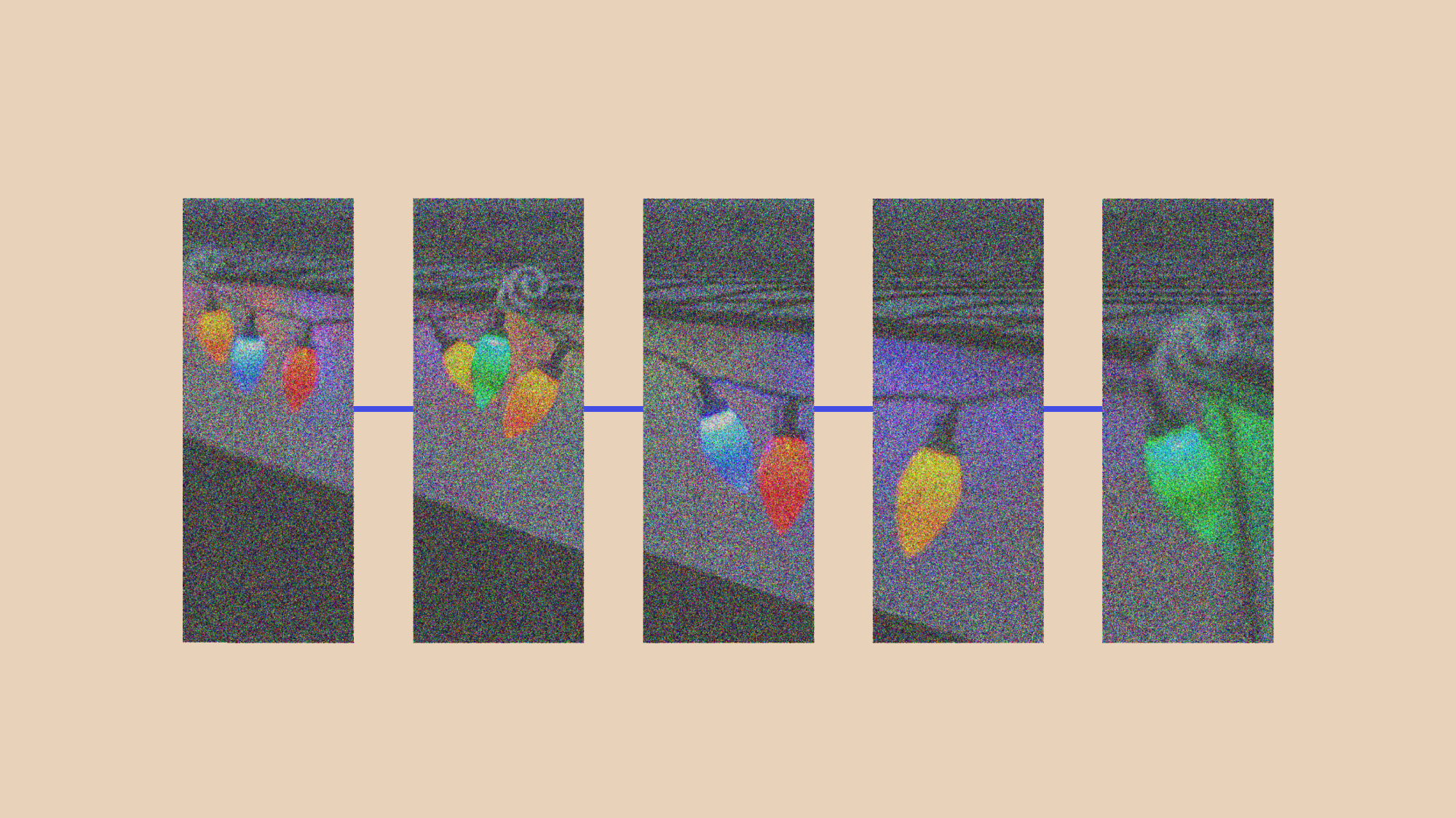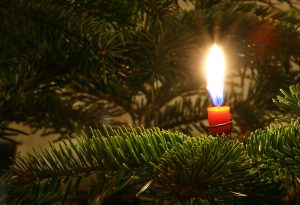Driving home in the dark on Thanksgiving weekend, I noticed many homes in my suburban town had strung holiday lights in their yards. The houses illuminated the early night brought about by daylight saving time, and for the first time this year, I was excited that the holiday season was underway. When I pulled into my driveway, mood lifted, I found my mom and younger brother outside wrestling with our own Christmas lights, uncharacteristically early for our family.
Feeling nostalgic and happy to be at home for this time of the year considering I’d typically be returning to campus for the end of the semester, I took my mom’s place untangling, testing, and stringing lights on a few bushes with my brother. As we finished and stepped back to admire our work, we both watched a string of lights flicker out, then blink back on. We looked at each other and laughed. “I didn’t see anything if you didn’t see anything,” he said, knowing that it would take a small miracle for that particular string to stay lit beyond a few days.
In a typical year, I would have questioned my mom for taking out the decorations that Saturday as I usually deem any time pre-December too early. This year, it’s different. COVID-19 has fostered a universal sense of anxiety. Uncertainties about the nature of the virus and timetables of solutions to the crisis have compounded the impact of isolation on mental health. With so many living alone or at home with their families, many are understandably tired of working, learning, and socializing virtually. The recent national surge in cases, deaths, and hospitalizations accompanies the shortening days and longer nights of winter. The U.S. has had one of the most devastating weeks since the pandemic began nine months ago, and health experts warn that the next few months could be the “darkest winter in modern history.” With seemingly no end to the pandemic in sight, strings of lights may not be much, but they shine through the bleakness of a difficult winter in isolation.
Seasonal holiday lights have little practical function. They are decorative and undeniably alluring. The combatant of darkness, symbolically, light is understood as calm, protective, and even cheerful. In recent years, the reasons behind the appeal of holiday lights have been both theorized and extensively researched. For some, the lights harken back to a sense of childhood nostalgia; for others, they represent a break from the stresses and anxieties of everyday life. This year, this reasoning is especially pertinent. Stringing holiday lights sparks joy, and not only for those decorating. As we spin in our local circles of isolation, the lights themselves encourage neighbors to connect: studies show neighbors often interpret decorations as expressions of friendliness and sociability. In other words, through their symbolic meaning, lights build community.
A few days before we decorated our own house, my aunt, who lives in Warwick, R.I., shared a story about how the town’s mayor-elect had encouraged the community to decorate for the holidays. Frank Picozzi, a contractor, ran for mayor this year as an independent and won in a landslide. It’s an interesting story of local politics, but according to my aunt, he had been building significant community traction over the years through an annual Christmas light display set up in his front yard.
With the display, Picozzi sets up a small collection box for The Tomorrow Fund, a non-profit charity that supports children battling cancer and their families at Hasbro Children’s Hospital. The annual display attracts thousands to drive by and view it with their families, and in turn, raises thousands of dollars for the non-profit. Picozzi also organizes a weeknight event where he and other volunteers bring flashlights to a parking lot across from the hospital to shine and signal goodnight to the young patients at their windows. Hearing about Picozzi’s efforts and his extravagant light display struck a personal chord; over a decade ago, my own cousin was treated at Hasbro Children’s and helped by The Tomorrow Fund.
As an extension of his own locally famous work, this year Picozzi encouraged everyone in Warwick to put up holiday lights, and put them up early. My aunt did, and so did an overwhelming number of her neighbors. Her own decorations included big colored light bulbs wrapped around the evergreen in her front yard and icicle-style string lights lining her porch. The colored lights were an annual nod to her and my father’s family decorations growing up. The icicle lights were my aunt’s adult addition to her childhood Christmas memories.
There’s an important universality to lighting displays. Not everyone celebrates a specific holiday, but all can appreciate seasonal lights and decorations. So many yards and windows radiate joy this time of year with different combinations of white, green, blue, or red string lights, or inflatable snow globes, or simple spotlights. The medley of decorations represents distinct meanings among individuals, families, and neighborhoods.
Winter lights historically and contemporarily maintain significance across cultural traditions. In the United States, the practice of stringing holiday lights outdoors developed after WWII as fantastical celebrations of post-war economic successes. The idea was an extension of lighted Christmas trees, while the luminary celebration of the modern holiday season developed from pagan festivals of the winter solstice. Biblically, the birth of Christ is marked by the appearance of a new, bright star. Jewish Hanukkah, celebrated in this same season, is also termed the “Festival of Lights.” Throughout the world, secular light festivals in each hemisphere’s winter months are growing increasingly popular. In the midst of the pandemic, viewing lights sitting in a car or standing safely distanced outside remains a low-risk activity.
Holiday lighting displays are also a powerful form of normalcy in a profoundly abnormal time. On Dec. 9 at 5 p.m., Georgetown President John DeGioia will be hosting a live Virtual Tree Lighting ceremony. The virtual spin on the annual event, which will still feature acapella holiday performances and a reading of “A Christmas Carol,” can be livestreamed on the university Facebook Page.
COVID-19 has attacked communities everywhere. With recent positive news of vaccine efficacy rates and subsequent distribution plans, for the first time, there seems to be a light at the end of the tunnel. Still, there are months of isolation and a long winter ahead. The pandemic in the U.S. is the worst it has been, and the next few months will put a strain on everyone, making it that much more important to build and maintain community bonds. This holiday season, consider stringing some lights in your window for neighbors. It may help remind us all that we’re still here, united together while apart.
In the return to class after Thanksgiving, my theology professor, Dale Irvin, kindly asked the class how the holiday had been. He then shared that he, too, had been encouraged to put up his Christmas lights over the holiday weekend, having seen some of his neighbors do the same. “At least people are putting up Christmas lights in this neighborhood, so it feels like a bit of community,” Irvin said.
As this tumultuous year comes to an end and the darkness of the pandemic winter looms, the lights in 2020 can illuminate universal meanings: the strength of communities and even hope.





